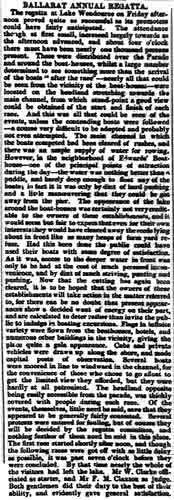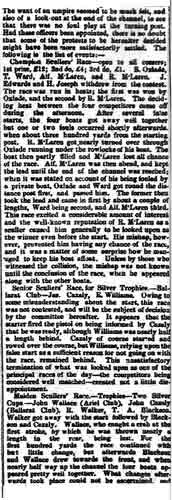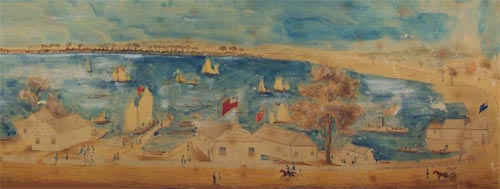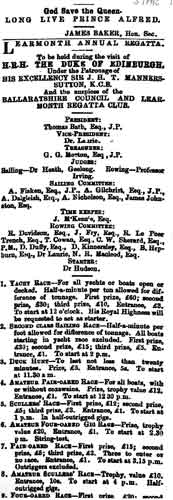The Boys from the Rush Beds
The History of the Ballarat City Rowing Club 1870-2004 and Incorporating the Early Development of Lake Wendouree 1860-70, By Kathryn M Elliott
1. Prelude
1865
On January 23rd a combined meeting of three rowing clubs was held, namely the Lubentia, Alabama and Ariel. The Ariel Club had been formed in late 1864. The meeting was held at the Camp Hotel and was for the purpose of forming a joint committee to organise a regatta embracing the whole of the Ballarat amateur aquatic world, styled on the Ballarat district regatta. It was to be held around the Easter holidays. The action of the Ballarat Club in organising the forthcoming Ballarat Regatta on February 10th was deprecated by all three clubs at this meeting as Ballarat had ignored the clubs by not putting on races that they had the class of boat to compete in.
Also at this meeting Mr. J. W. Graham moved that the three clubs not enter Ballarat Regatta because of the short notice. This disillusionment with the way Ballarat Rowing club treated the newcomers may well have given rise to J. W. Graham and others thinking about forming a new club. There were obviously a significant number of the rowing fraternity who did not see eye to eye with the Ballarat Rowing Club under the captaincy of Ned Williams. He was no doubt a strong character and had many differences of opinion both on and off the water.
On January 30th it was reported that the level of the lake had fallen another 12 to 18 inches and was looking rather woebegone. There was still enough water for rowing boats to float on but the closeness of the reeds to the surface made rowing rather laborious. With the low water level, the subsequent lack of rowing activity and the cavalier treatment by Ballarat Rowing Club, the Lubentia (formerly the Tay) Club met on the February 2nd 1865 to wind up their affairs. The club’s only boat was bought by Mr Jack of the British Hotel. There was mention made in the Star that a new club was likely to be formed.
So on Friday the 11th of February 1865 the very first Ballarat Regatta was held on Lake Wendouree one year after Robinson McClaren first ventured out across the Swamp. Ariel and Ballarat Rowing Club entered along with scullers from Geelong and Melbourne. About 1000 people attended. There were seven races contested, Champion sculls-open to all comers, Senior sculls, pairs and fours, Maiden pairs, fours and sculls. The Senior four was won by the Ballarat Club with a crew comprising P. Cazaly, John Cazaly, Ned Williams and James Cazaly was the stroke. With three Cazalys in the crew the win continued to contribute to the growing legendary sporting prowess of the Cazalys. The Champion Scullers’ race was also won by a sporting legend, Ben Oxlade, who had been a professional rower in England and a member of the Doggett Coat boatmen of the River Thames. The four-oared gigs used were the FANNY and the SYLPH along with the pair-oared gigs SURPRISE, MONITOR and COMET.
The Alabama Club did not compete but held a meeting on the 10th of February (the day of the regatta) at which Mr. J. W. Graham was again present.


The inaugural Ballarat Regatta, excerpt from the Star newspaper report, Saturday,11th February, 1865.
On March 20th it was reported in the Star, “Late rains had added appreciably to the volume of water in the lake.” Then on March 31st the Ballarat Club held a sculling match race on Lake Learmonth over a two-mile course. J. Cazaly defeated E. Williams and Williams protested, which was pretty much true to form for Ned!
On July 8th 1865 Dr. Whitcombe, a founding member of the Regatta Club (now the Ballarat Rowing Club), tendered his resignation as secretary at that meeting of the club. A letter was also received from the Ariel Club requesting terms on which it might amalgamate with Ballarat. They did amalgamate not long after. The Ballarat Club also purchased a scull at the cost of 20 pounds.
On August 2nd the Alabama Club met and resolved to send three crews to the upcoming Melbourne Regatta and secretary James Bell was instructed to apply to the Railway department for free transit of the club’s boats and to request the Ballarat Club to make a joint approach. Unfortunately, the Melbourne Regatta of 1865 was not held due to a disastrous flood on the Yarra in ‘64 that had carried away boatsheds and boats. So extensive was the damage that they had not recovered sufficiently to stage this year’s regatta. At the next meeting of the Alabama Club on August 30th, correspondence was also received from the Ballarat Club declining to accept the challenge issued after Ballarat Regatta.
Alabama celebrated the opening of the season on September 7th with Ballarat Rowing Club having held their opening on August 12th. On August 26th the lake was reported to be very busy on Friday afternoon with all manner of boats about. Comment was made that the ugly hollows near the boathouses have not yet been filled, referring to the remnant workings of quarry men and miners particularly on the area now known as View Point.
Captain Golightly chaired the October 5th meeting of Alabama and dissatisfaction was expressed that the Melbourne Regatta had been postponed until March 1866 as it was felt that the Lake would be so low in summer that it would make training difficult, if not impossible and the club would not be in a position to compete fairly with their metropolitan counterparts. The building of a new boathouse was discussed and an application was to be made to the Water Commission. Several new boats were ordered from Mr. Greenland in Melbourne and club membership was steadily increasing with about 40 on the books. A sculling race between Mr. Petrie of Alabama and John Cazaly of the Ballarat Club was arranged for October 13th with the prize being 10 pounds. Cazaly won. The Star reported on Wednesday the 18th that a “good afternoon’s sport appears to be in store for Friday November 10th with several rowing matches being arranged-one a sculling match between Captain Williams and Captain Golightly of Alabama.”
Later in October the Alabama Club accepted a tender for the erection of a boathouse. The building was to be 45ft by 20ft and constructed nearly opposite Williams Hotel. Bob McClaren dropped out of view at the end of October 1865 and was not active again in rowing circles.He died in 1867 having had the foresight and the drive to get rowing started he did live to see just how far his vision would take Yuille’s Swamp.
On October 16th at a meeting of the Water Commission a proposal was made to fence the lake to stop wandering cattle straying and polluting the waters.
By the end of October conditions in Ballarat were described as ‘parching drought’. Discussion was also happening in the wider community about altering the weekly half-day holiday from Friday to Saturday. At this point in time some people still adhered to the Friday whilst some supported the change to Saturday. Obviously the change was to have profound social impact on when and where sport was played. On November 10th Ned Williams attended a regatta on the Upper Yarra and came home the victor. On November 17th the Lake hosted a juvenile sculling race. Three boys aged seven and a half, eight and a half and nine respectively, competed for 7 pounds prize money. Young Oxlade won by 3 lengths and it was decided that the other two boys should receive something for their efforts also. These boys were obviously the sons of the men who hired out boats for a living being Edwards boatshed, Wards and the son of Ben Oxlade who was a successful professional waterman from England.
The following week a sculling match was held between Davidson and Walker for a prize of 5 pounds. Then on November 25th more boys rowing matches concluding with a tub race in which many of the youthful competitors came to grief. At the end of November a tender was called to recut the existing channels in the reeds as they were rapidly growing over . An iron steamer for use on the lake was being constructed by Soho Foundry and was due to be ready by Boxing Day.
On December 1st the Alabama Club moved its boats into the new boathouse and on December 7th the new iron steamer VICTORIA was the very first paddle steamer to be launched on the Lake.

W.Tibbits, Lake Wendouree, Ballarat. A view taken from the roof of Mr. Brown’s Flour Mill. Listed as circa 1880 but more likely circa 1865.
Courtesy of the Ballarat Historical Society.
Landmarks in the Tibbits Painting
The Tibbits painting is the earliest picture of the first boatsheds on the Lake. It also shows the first steamer VICTORIA so the picture must have been painted after the steamer was first launched.
The boatshed on the left is that of Gates and Sons, boat-builders, and was built in mid 1864. Next to that there is the jetty built by Mr.Edwards for the convenience of his patrons and right next to it is the boatshed of Edwards and Gill (Gill’s restored boatshed is still on the site today).
The next shed is Ballarat Rowing Club’s with the tall gum treeout the front and with a flag flying on the lake end of the shed. Beside that, the boat yard of T.Ward who ran his boat hire business from the shore opposite the Wheatsheaf Hotel.
Finally, on the far right, is the Alabama boatshed built in October 1865. The surrounding environment is straggly, low-growing eucalypt trees on the far shore. A picket fence runs along the edge of Wendouree Parade.
The original dating of this painting is incorrect as by 1880 many more improvements had been made and plantings of European shrubs and trees would have changed the appearance of the Lake.
1866 The Dry Years ‘66-‘69
Early in January 1866 the half-holiday was changed from Friday to Saturday so the weekend as we know it today came into being.
The long anticipated sculling match that had been mooted in early November 1865 between Ned Williams of the Ballarat Club and Henry Golightly of the Alabama Club finally took place on Saturday January 14th 1866. The trophy was to be twenty pounds and the winner to donate 5 pounds to the Ballarat and District Hospital. Mr Golightly came home the winner but not without the controversy that seemed to follow many of the races involving Ned Williams. It was claimed that Williams ‘fouled’ his opponent by rowing into his lane. Ned, ever ready with an answer, replied that he was rowing under Thames rules that allowed a sculler to take his opponent’s water if he was leading. The judges remained unmoved and Mr Golightly was awarded the prize. A dinner in his honour was held at Jack’s Caledonian Hotel. Mr Hodgson took the chair and Dr. Whitcombe, recently resigned from the Ballarat Club, was the vice-chair.
By mid-February the water level was again so low as to render rowing extremely difficult, if not impossible. There was seldom a boat of any kind to be seen. Again almost daily in letters to the Editor in all the newspapers, evidenced agitation for the two Councils to make more of an effort to preserve the water in the lake and stop it drying up. In mid March the fire brigade was called to a fire on the lake and had to beat it out with sticks, as there was no water to be had. This gave rise to the idea - why not burn the lake to clear it of the troublesome reeds and rushes. This they did, and on Saturday April 7th the grass and reeds were fired and a great glare reflected in the evening sky. A letter to the editor on March 14th also made the suggestion that the prisoners from the Ballarat Goal be set to work to clear the Lake. Again this suggestion was taken up much later with the prisoners forming paths and planting trees in 1867.
A public meeting was held at the Mechanics’ Institute on April 13th 1866 chaired by the Mayor for the purpose of discussing several proposals for the converting of Lake Wendouree into an ornamental sheet of water. As the water was at a lower level than it had been for years with up to 600 yards out dry ground, some lake enthusiasts thought that it should be dug up or ploughed while so much was dry. As it was the occupiers of the boathouses did a good deal of earthwork during the dry season with high hopes of a “perfect lake” when the rains came.
With no water for rowing activities the Alabama Club had an emergency meeting on May 12th to consider how they might best clear their existing liabilities. It was agreed that each member should be requested to pay a monthly small sum until all the debts were paid. Rain began falling on May 18th, The Star reporting “steady, continuous, copious rain had started to fill the basin”.
The two Councils decide to call for designs to achieve the goal of an ornamental sheet of water. A first prize of 30 pounds and a second prize of 20 pounds were offered with the funds for the prize money to be derived from boathouse rentals.
In July there was a report of snow falling in the district and Lake Learmonth reportedly was covered in ice. Rain continued to increase the water in the lake.
By August the lake had sufficiently filled to allow boating to commence. In mid August the lake rose four inches in one week allowing “ardent votaries of the oar” to “spurt” up and down the old central channel which was then the only open space.
On September 4th 1866, the Ballarat Rowing Club held its second annual meeting. It was mentioned how much the club owed Mr Robinson McClaren and Mr William Clarke the two men responsible for founding the club. Mr. McClaren who had now moved to Melbourne and Mr. Clarke who was living in Mt Clear were elected as the first life members of the club. The rains continued and by October the increased depth allowed the steamer Victoria to make her first voyage of the season.
The second Ballarat Regatta was held on Lake Wendouree on November 9th 1866 and was fairly successful held in lovely weather with entries from Ballarat, Alabama, Corio and Melbourne.
This is an extract from the report that appeared in the Star on Saturday, November 10th:
“On Friday the Ballarat regatta took place on Lake Wendouree, under the most favourable auspices. The weather…..was everything that could be desired, and the attendance was fully as large as could have been expected; in fact, at one time in the afternoon the parade in front of the boathouses was crowded, whilst the grass banks in their neighbourhood and fronting the Lake were largely occupied by visitors from all parts of town. The appearance of the place was in itself quite a sight, altogether apart from the racing, which, unfortunately, from the state of the lake ,was, of course, almost unseen, at least during nearly the whole of the distance, by the large majority present. When so many people congregate, as on Friday, to see the start and finish only of each race…the impossibility of witnessing the races ….has always been and will be the great drawback to the success of regattas on the Lake Wendouree, and until the course shall have been made in front of the parade, and bought in view of everybody….regattas will not be so attractive as they might be……….
The channel was crowded with boats of all dimensions and as each race took place they were drawn up on the sides of the channel with very praiseworthy promptitude, so as to be out of the way of any competing boats.”
Several of the races on the program were scratched. The Maiden scullers’ race did not come off owing to Mr Bell being indisposed nor did the Senior scullers’ race due to Mr Ned Williams being too unwell to race John Cazaly. There was an unfortunate dispute about the outcome of the Maiden fours. The Alabama crew was disqualified in the Maiden fours event and the Star report cast the club in a poor light stating that their behaviour had been reprehensible.
Alabama’s secretary, James Bell, voiced his unhappiness with the reporting of the event in the Star newspaper in a letter to the Editor:
“The fouling of the Alabama crew in the four-oared maiden gig race was all the more to be deprecated since it was practised on strangers. We admit, sir, that a foul took place. but whose fault was it? Was it not the starter who allowed the boats to start from a position that they could not inevitably have avoided coming into contact in the first few strokes...why wasn’t the race restarted? People did cheer Alabama (report stated that dead silence greeted the crew at the line, whereas Corio was cheered!). We will never again have anything to do with a regatta where the captain of the Ballarat Club has anything to do with its management.”

The Brothers McClaren
In sketching young Alf Mc Claren we are in the position of Canning’s knife-grinder when he said “Story, lord love yer honour, I have none to tell.” We can only say, therefore that he was born on London, is 21 years of age, of Scotch parentage, in condition weighs a little over 11 stone and arrived here 18 months since on the TRUE BRITON. From the time he landed in the colony he has had an insatiable ambition to display his prowess in the prize ring. This feeling, probably, had its origins from reading the deeds of arms with which his brother’s name was gilded.
One event, however, since his arrival redounds so highly to his credit and gained him so many friends on Ballarat, that a record of fact will not be out of place. While practising rowing on Lake Burrumbeet in a light pair-oared boat with the late Mr.J.W.Pringle, the craft filled, swamped and turned them both out. After being in the water for some hours, Alf volunteered to swim for assistance. To this his companion objected, begging him not to leave him. At the risk of his own life Alf remained with him until he sank exhausted.
Alf himself was in the water nine hours with waves washing over him and when picked up was nearly delirious. His powers of endurance were amply proved on that occasion and his endeavours to save his unfortunate companion gained him the friendship of many of the denizens of the metropolitan goldfield. Soon after making a match he went into active training at the Picnic Hotel, accompanied by an oarsman and was visited at intervals by his brother, from whom he received many valuable hints and occasional practice.
Apropos of Alf’s brother(Bob), having alluded to his fame, we may mention that he is well known to Londoners as Peter Crawley’s “Young Big ‘Un”, but as a proportion of our readers are not Cockneys, we may state that, when in London, he, under the auspices of Peter Crawley, challenged Tom paddock and the “Tipton Slasher.” Unable to get a match, he went on tour with Tass Parker to Scotland where he was matched against Jemmy Mc Mulken for 100 pounds and the Championship of Scotland. The fight came off at Netherbridge, Dumfries, on the 24th December 1860,but owing to the shortness of the day, the fight was not finished. McMulken was, however, dreadfully punished and declined to meet Bon again, relinquishing all claims to the championship.
McClaren afterwards went to New York, with the intention of getting “on “there, but on his arrival, Tom Hyer had clinched a bargain with Yankee Sullivan, and Bob, rather than be idle, was glad of the job to train Tom. He succeeded in making his protégé the winner, and soon after left for California, where under the nomme de guerre of George Thompson, he fought and beat Marshall Willis for $4,000 and the Champion belt, which said belt may be seen, at any time, at Bob’s hotel on Ballarat.
He was afterwards matched against Johnny Morrisey who beat Heenan, but from the first it was seen that the “Britisher” was not to win and on the slightest pretence, Morrisey was taken from the ring and subsequently claimed the stakes. Bob having a bad stakeholder, had to grin and bear it, though the Press stigmatised the proceedings as extremely unfair to Bob. Seeking fresher fields and pastures new, he reached these shores in 1853, and, unable to get a match, settled down as a publican.
In 1856 he made a flying trip to England and on his return, opened the Glasgow Arms on Ballarat, where he was patronised so extensively that he was able to purchase the freehold of the Colonial Bank, the building now known as McClaren’s Hotel. Being better educated than most of his class, and of thoroughly honourable principles, he has succeeded, as Peter Crawley’s “Young Big ‘Un”, as George Thompson and as Bob McClaren, in gaining in both hemispheres, the goodwill-nay, the esteem-of all straight forward sporting men and is regarded as an example to be copied by all embers of the corps pugilistique.
(Bell’s Life in Victoria and Sporting Chronicle,Saturday August 1st,1863.)

